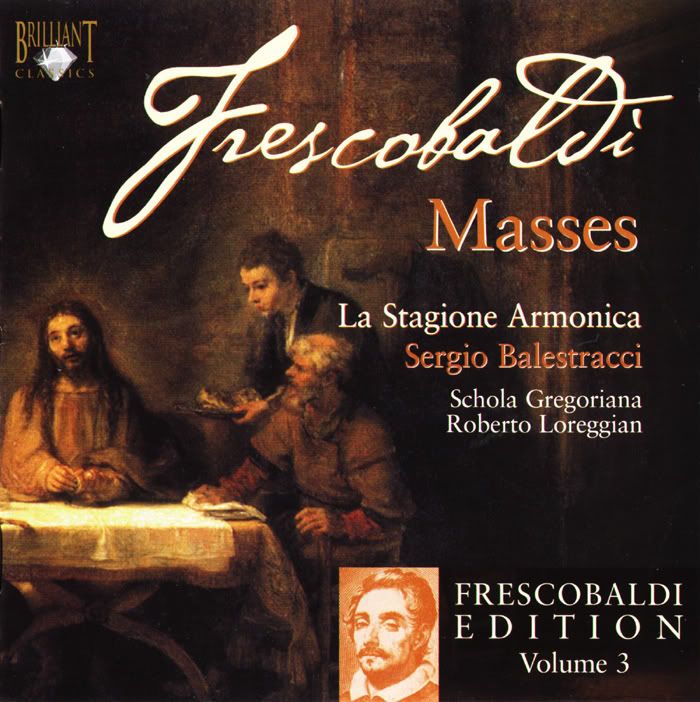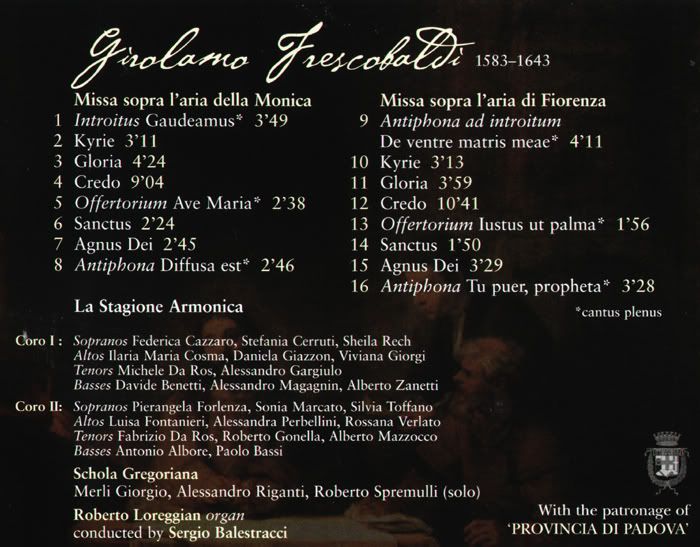Pro Member
Group: Members
Posts: 695
Warn:0%
|
 |
|
Girolamo Frescobaldi (1583 - 1643)MassesLabel: Brilliant Classics, 93780 Year: 2008 Performers:Roberto Loreggian - organ La Stagione Armonica Schola Gregoriana Sergio Balestracci - conductor Tracklist:Missa Sopra l'aria della Monica01. Introitus 02. Kyrie 03. Gloria 04. Credo 05. Offertorium 06. Sanctus 07. Agnus dei 08. Antiphona Missa Sopra l'aria di Fiorenza09. Antiphona ad Introitum 10. Kyrie 11. Gloria 12. Credo 13. Offertorium 14. Sanctus 15. Agnus dei 16. Antiphona Girolamo Frescobaldi was born in Ferrara in 1583, and worked for the influential and wealthy Este family. Ferrara at this time had become the centre for the modern arts and the musical avant-garde. Virtuoso singing and playing flourished, and it was into this heady atmosphere that the young Frescobaldi cut his teeth.
In 1608 he took the position of organist at St Peter's Basilica in Rome. In 1615 a new basilica was built with two fine organs upon which Frescobaldi performed his famous improvisatory toccatas during ceremonial occasions. In Rome at this time he mingled with other major figures in the artistic community including Bernini and Pietro da Cortona.
Although Frescobaldi was one of the earliest composers to make keyboard compositions his speciality, he was also expected to provide vocal and choral works for his patron.
On the third volume of the Brilliant Classics Frescobaldi Edition are two Masses that have survived in manuscript partbooks, inscribed 'G.F.di', which scholars believe is a reference to Frescobaldi. It is likely that these masses were performed in the basilica, and Frescobaldi uses popular songs as the basis for both works. One is a song of a girl pleading with her mother not to send her to a convent, the other a song composed for the wedding of the Grand Duke of Tuscany in 1589. Both works are beautifully crafted examples of late 17th-century Italian church music.These masses have been preserved in a single manuscript in the library of the Basilica of St John Lateran in Rome. On the organ part of the first of these two masses one finds the letters G. F.di. This has led to these masses being attributed to Frescobaldi. Although their authenticity can't be established with absolute certainty, most scholars believe they were indeed composed by Frescobaldi. It was a good decision to include them in this project since they are of fine quality and give a good picture of the kind of liturgical music which was composed during Frescobaldi's life.
They reflect common practice in Rome in that they are scored for eight voices in two choirs. The two choirs are used to create antiphonal effects. Sometimes they alternate in singing the various verses of the mass, sometimes the one choir repeats a phrase of the other. At some moments they join to underline important passages and in other instances only one choir sings, for instance in 'Et incarnatus est' and 'Crucifixus' in the Credo. In both masses the Benedictus and the second Agnus Dei are left out; these are sung here in plainchant. Both masses are extended by plainchant settings of parts of the Proper of the Mass. In the Missa sopra l'aria della Monica the Introitus, Offertorio and Communion from the Mass for the Virgin Mary are added, whereas in the Missa sopra l'aria di Fiorenza the additional chants are taken from the Mass of St John the Baptist.
Both masses are based on tunes which were quite popular at the time. The aria della Monica was a secular song, and quite often used for keyboard variations and instrumental compositions. The aria di Fiorenza is also known as Ballo del Granduca, and was first composed as the song O che nuovo miracolo by Emilio de' Cavalieri. This was included in the Intermedii which were performed at the wedding of Grand-Duke Ferdinando I and Christine of Lorraine in 1589. This tune was also often used, for instance by Jan Pieterszoon Sweelinck.
La Stagione Armonico consists of 28 singers, divided over the two choirs. Although I would have preferred a slighter smaller ensemble, the sound is quite transparent. Furthermore the singing is outstanding, and the choir shows great rhythmic vitality. The two vocal groups are audibly split, but fortunately they haven't been put too far away from each other. The plainchant is also beautifully sung, and as a result this disc can be unequivocally recommended.
Roberto Loreggian delivers very good performances. Many pieces are quite short, in particular the Kyrie and Christe settings, and they can appear quite short-winded. The fact that the are alternated by the appropriate plainchant helps to prevent that. The singing of the Schola Gregoriana is bright and clear. Of course, it would be nice to hear all pieces within the liturgical context for which they were intended. To my knowledge no such recording exists. So we have to be satisfied with this recording. The quality and variety of Frescobaldi's music and Roberto Loreggian's level of playing is such that that's no tall order.  | SPOILER (LOG FILE) | Exact Audio Copy V1.0 beta 1 from 15. November 2010
EAC extraction logfile from 19. April 2011, 13:56
La Stagione Armonica, Schola Gregoriana / Girolamo Frescobaldi - Masses
Used drive : HL-DT-STDVDRAM GSA-H62N Adapter: 2 ID: 1
Read mode : Secure
Utilize accurate stream : Yes
Defeat audio cache : Yes
Make use of C2 pointers : No
Read offset correction : 667
Overread into Lead-In and Lead-Out : No
Fill up missing offset samples with silence : Yes
Delete leading and trailing silent blocks : No
Null samples used in CRC calculations : Yes
Used interface : Installed external ASPI interface
Gap handling : Appended to previous track
Used output format : User Defined Encoder
Selected bitrate : 256 kBit/s
Quality : High
Add ID3 tag : No
Command line compressor : C:\Program Files\Exact Audio Copy\Flac\flac.exe
Additional command line options : -8 -V -T "ARTIST=%a" -T "TITLE=%t" -T "ALBUM=%g" -T "DATE=%y" -T "TRACKNUMBER=%n" -T "TOTALTRACKS=%x" -T "GENRE=%m" -T "ALBUMARTIST=%v" -T "ALBUM ARTIST=%v" -T "COMMENT=EAC Secure Mode, Test & Copy, AccurateRip, FLAC -8" %s
TOC of the extracted CD
Track | Start | Length | Start sector | End sector
---------------------------------------------------------
1 | 0:00.00 | 3:49.63 | 0 | 17237
2 | 3:49.63 | 3:11.30 | 17238 | 31592
3 | 7:01.18 | 4:24.00 | 31593 | 51392
4 | 11:25.18 | 9:04.45 | 51393 | 92237
5 | 20:29.63 | 2:38.00 | 92238 | 104087
6 | 23:07.63 | 2:24.60 | 104088 | 114947
7 | 25:32.48 | 2:45.00 | 114948 | 127322
8 | 28:17.48 | 2:55.15 | 127323 | 140462
9 | 31:12.63 | 4:11.00 | 140463 | 159287
10 | 35:23.63 | 3:13.45 | 159288 | 173807
11 | 38:37.33 | 3:59.60 | 173808 | 191792
12 | 42:37.18 | 10:41.45 | 191793 | 239912
13 | 53:18.63 | 1:56.00 | 239913 | 248612
14 | 55:14.63 | 1:50.00 | 248613 | 256862
15 | 57:04.63 | 3:29.00 | 256863 | 272537
16 | 60:33.63 | 3:28.12 | 272538 | 288149
Track 1
Filename G:\A\Girolamo Frescobaldi - Masses (2008) [FLAC]\01 - Missa sopra l'aria della Monica - Introitus Gaudeamus.wav
Pre-gap length 0:00:02.00
Peak level 21.9 %
Extraction speed 2.7 X
Track quality 100.0 %
Test CRC DE8DBFA3
Copy CRC DE8DBFA3
Track not present in AccurateRip database
Copy OK
Track 2
Filename G:\A\Girolamo Frescobaldi - Masses (2008) [FLAC]\02 - Missa sopra l'aria della Monica - Kyrie.wav
Peak level 88.7 %
Extraction speed 2.6 X
Track quality 100.0 %
Test CRC 0484F2E8
Copy CRC 0484F2E8
Track not present in AccurateRip database
Copy OK
Track 3
Filename G:\A\Girolamo Frescobaldi - Masses (2008) [FLAC]\03 - Missa sopra l'aria della Monica - Gloria.wav
Peak level 99.7 %
Extraction speed 2.4 X
Track quality 99.9 %
Test CRC 31296877
Copy CRC 31296877
Track not present in AccurateRip database
Copy OK
Track 4
Filename G:\A\Girolamo Frescobaldi - Masses (2008) [FLAC]\04 - Missa sopra l'aria della Monica - Credo.wav
Peak level 99.7 %
Extraction speed 3.0 X
Track quality 100.0 %
Test CRC 06326B1F
Copy CRC 06326B1F
Track not present in AccurateRip database
Copy OK
Track 5
Filename G:\A\Girolamo Frescobaldi - Masses (2008) [FLAC]\05 - Missa sopra l'aria della Monica - Offertorium Ave Maria.wav
Peak level 16.6 %
Extraction speed 2.5 X
Track quality 100.0 %
Test CRC 2811D1EE
Copy CRC 2811D1EE
Track not present in AccurateRip database
Copy OK
Track 6
Filename G:\A\Girolamo Frescobaldi - Masses (2008) [FLAC]\06 - Missa sopra l'aria della Monica - Sanctus.wav
Peak level 99.8 %
Extraction speed 2.0 X
Track quality 99.9 %
Test CRC 7C6EF99E
Copy CRC 7C6EF99E
Track not present in AccurateRip database
Copy OK
Track 7
Filename G:\A\Girolamo Frescobaldi - Masses (2008) [FLAC]\07 - Missa sopra l'aria della Monica - Agnus Dei.wav
Peak level 87.0 %
Extraction speed 2.6 X
Track quality 100.0 %
Test CRC 52B4FA0A
Copy CRC 52B4FA0A
Track not present in AccurateRip database
Copy OK
Track 8
Filename G:\A\Girolamo Frescobaldi - Masses (2008) [FLAC]\08 - Missa sopra l'aria della Monica - Antiphona Diffusa est.wav
Peak level 15.4 %
Extraction speed 2.6 X
Track quality 100.0 %
Test CRC A6C1DBF1
Copy CRC A6C1DBF1
Track not present in AccurateRip database
Copy OK
Track 9
Filename G:\A\Girolamo Frescobaldi - Masses (2008) [FLAC]\09 - Missa sopra l'aria de Fiorenza - Antiphona ad introitum.wav
Pre-gap length 0:00:08.73
Peak level 17.8 %
Extraction speed 2.8 X
Track quality 100.0 %
Test CRC 42E18166
Copy CRC 42E18166
Track not present in AccurateRip database
Copy OK
Track 10
Filename G:\A\Girolamo Frescobaldi - Masses (2008) [FLAC]\10 - Missa sopra l'aria de Fiorenza - Kyrie.wav
Peak level 93.8 %
Extraction speed 2.3 X
Track quality 99.9 %
Test CRC 0CC46E53
Copy CRC 0CC46E53
Track not present in AccurateRip database
Copy OK
Track 11
Filename G:\A\Girolamo Frescobaldi - Masses (2008) [FLAC]\11 - Missa sopra l'aria de Fiorenza - Gloria.wav
Peak level 99.8 %
Extraction speed 2.8 X
Track quality 100.0 %
Test CRC 2D6F7DE6
Copy CRC 2D6F7DE6
Track not present in AccurateRip database
Copy OK
Track 12
Filename G:\A\Girolamo Frescobaldi - Masses (2008) [FLAC]\12 - Missa sopra l'aria de Fiorenza - Credo.wav
Peak level 99.8 %
Extraction speed 3.1 X
Track quality 100.0 %
Test CRC ABCA6491
Copy CRC ABCA6491
Track not present in AccurateRip database
Copy OK
Track 13
Filename G:\A\Girolamo Frescobaldi - Masses (2008) [FLAC]\13 - Missa sopra l'aria de Fiorenza - Offertorium-Iustus ut palma.wav
Peak level 20.3 %
Extraction speed 2.4 X
Track quality 100.0 %
Test CRC BD4D76E7
Copy CRC BD4D76E7
Track not present in AccurateRip database
Copy OK
Track 14
Filename G:\A\Girolamo Frescobaldi - Masses (2008) [FLAC]\14 - Missa sopra l'aria de Fiorenza - Sanctus.wav
Peak level 99.8 %
Extraction speed 2.4 X
Track quality 100.0 %
Test CRC BEA7E66C
Copy CRC BEA7E66C
Track not present in AccurateRip database
Copy OK
Track 15
Filename G:\A\Girolamo Frescobaldi - Masses (2008) [FLAC]\15 - Missa sopra l'aria de Fiorenza - Agnus Dei.wav
Peak level 41.1 %
Extraction speed 2.7 X
Track quality 100.0 %
Test CRC 72AECA54
Copy CRC 72AECA54
Track not present in AccurateRip database
Copy OK
Track 16
Filename G:\A\Girolamo Frescobaldi - Masses (2008) [FLAC]\16 - Missa sopra l'aria de Fiorenza - Antiphona-Tu puer, propheta.wav
Peak level 14.4 %
Extraction speed 2.8 X
Track quality 100.0 %
Test CRC 9ABE0216
Copy CRC 9ABE0216
Track not present in AccurateRip database
Copy OK
None of the tracks are present in the AccurateRip database
No errors occurred
End of status report
==== Log checksum 1221AD5DC911CB9EC78F21FB35BBA8EF9E1650303926F9406C84B6094098141A ==== |
This post has been edited by kgkk on 25-05-2011, 22:02 |

 Help
Help
 Search
Search
 Members
Members
 Gallery
Gallery
 Calendar
Calendar





